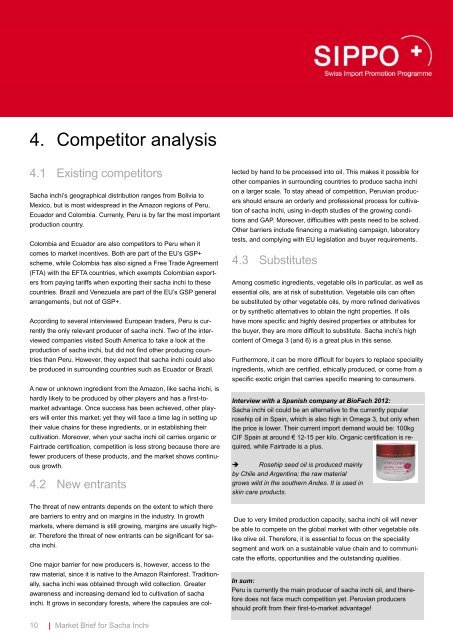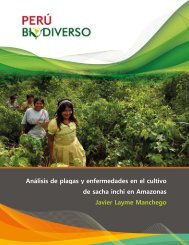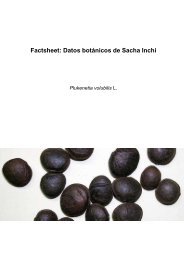Market Brief for Sacha Inchi.
Market Brief for Sacha Inchi.
Market Brief for Sacha Inchi.
You also want an ePaper? Increase the reach of your titles
YUMPU automatically turns print PDFs into web optimized ePapers that Google loves.
4. Competitor analysis<br />
4.1 Existing competitors<br />
<strong>Sacha</strong> inchi’s geographical distribution ranges from Bolivia to<br />
Mexico, but is most widespread in the Amazon regions of Peru,<br />
Ecuador and Colombia. Currenly, Peru is by far the most important<br />
production country.<br />
Colombia and Ecuador are also competitors to Peru when it<br />
comes to market incentives. Both are part of the EU’s GSP+<br />
scheme, while Colombia has also signed a Free Trade Agreement<br />
(FTA) with the EFTA countries, which exempts Colombian export-<br />
ers from paying tariffs when exporting their sacha inchi to these<br />
countries. Brazil and Venezuela are part of the EU’s GSP general<br />
arrangements, but not of GSP+.<br />
According to several interviewed European traders, Peru is cur-<br />
rently the only relevant producer of sacha inchi. Two of the inter-<br />
viewed companies visited South America to take a look at the<br />
production of sacha inchi, but did not find other producing coun-<br />
tries than Peru. However, they expect that sacha inchi could also<br />
be produced in surrounding countries such as Ecuador or Brazil.<br />
A new or unknown ingredient from the Amazon, like sacha inchi, is<br />
hardly likely to be produced by other players and has a first-to-<br />
market advantage. Once success has been achieved, other play-<br />
ers will enter this market; yet they will face a time lag in setting up<br />
their value chains <strong>for</strong> these ingredients, or in establishing their<br />
cultivation. Moreover, when your sacha inchi oil carries organic or<br />
Fairtrade certification, competition is less strong because there are<br />
fewer producers of these products, and the market shows continu-<br />
ous growth.<br />
4.2 New entrants<br />
The threat of new entrants depends on the extent to which there<br />
are barriers to entry and on margins in the industry. In growth<br />
markets, where demand is still growing, margins are usually high-<br />
er. There<strong>for</strong>e the threat of new entrants can be significant <strong>for</strong> sa-<br />
cha inchi.<br />
One major barrier <strong>for</strong> new producers is, however, access to the<br />
raw material, since it is native to the Amazon Rain<strong>for</strong>est. Tradition-<br />
ally, sacha inchi was obtained through wild collection. Greater<br />
awareness and increasing demand led to cultivation of sacha<br />
inchi. It grows in secondary <strong>for</strong>ests, where the capsules are col-<br />
10 | <strong>Market</strong> <strong>Brief</strong> <strong>for</strong> <strong>Sacha</strong> <strong>Inchi</strong><br />
lected by hand to be processed into oil. This makes it possible <strong>for</strong><br />
other companies in surrounding countries to produce sacha inchi<br />
on a larger scale. To stay ahead of competition, Peruvian produc-<br />
ers should ensure an orderly and professional process <strong>for</strong> cultiva-<br />
tion of sacha inchi, using in-depth studies of the growing condi-<br />
tions and GAP. Moreover, difficulties with pests need to be solved.<br />
Other barriers include financing a marketing campaign, laboratory<br />
tests, and complying with EU legislation and buyer requirements.<br />
4.3 Substitutes<br />
Among cosmetic ingredients, vegetable oils in particular, as well as<br />
essential oils, are at risk of substitution. Vegetable oils can often<br />
be substituted by other vegetable oils, by more refined derivatives<br />
or by synthetic alternatives to obtain the right properties. If oils<br />
have more specific and highly desired properties or attributes <strong>for</strong><br />
the buyer, they are more difficult to substitute. <strong>Sacha</strong> inchi’s high<br />
content of Omega 3 (and 6) is a great plus in this sense.<br />
Furthermore, it can be more difficult <strong>for</strong> buyers to replace speciality<br />
ingredients, which are certified, ethically produced, or come from a<br />
specific exotic origin that carries specific meaning to consumers.<br />
Interview with a Spanish company at BioFach 2012:<br />
<strong>Sacha</strong> inchi oil could be an alternative to the currently popular<br />
rosehip oil in Spain, which is also high in Omega 3, but only when<br />
the price is lower. Their current import demand would be: 100kg<br />
CIF Spain at around € 12-15 per kilo. Organic certification is required,<br />
while Fairtrade is a plus.<br />
� Rosehip seed oil is produced mainly<br />
by Chile and Argentina; the raw material<br />
grows wild in the southern Andes. It is used in<br />
skin care products.<br />
Due to very limited production capacity, sacha inchi oil will never<br />
be able to compete on the global market with other vegetable oils<br />
like olive oil. There<strong>for</strong>e, it is essential to focus on the speciality<br />
segment and work on a sustainable value chain and to communi-<br />
cate the ef<strong>for</strong>ts, opportunities and the outstanding qualities.<br />
In sum:<br />
Peru is currently the main producer of sacha inchi oil, and there<strong>for</strong>e<br />
does not face much competition yet. Peruvian producers<br />
should profit from their first-to-market advantage!









